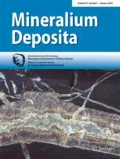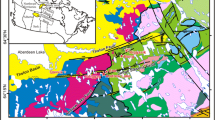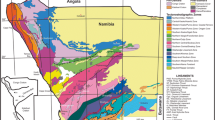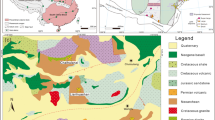Abstract
Gold mineralization in the Kolar schist belt of the Dharwar craton occurs dominantly in the form of a sulfide-poor Au-quartz lode (the Champion lode exposed in the Mysore and other mines) and sulfide-rich auriferous lodes (from the Nundydroog mine). Fluid inclusion microthermometric experiments were conducted on primary inclusions in quartz intimately associated with Au-mineralization. Homogenization studies on aqueous-biphase (L + V), aqueous polyphase (L + V+ halite) and aqueous-carbonic (LCO2± VCO2 + Laq) inclusions from the Champion lode furnish a temperature range of 120 to 420 °C. Freezing of aqueous biphase inclusions and dissolution of halite in the aqueous polyphase inclusions provide salinity of 5 to 50 wt.% NaCl equivalent. Fluid inclusion thermobarometry from the total homogenization of aqueous-carbonic inclusions and from intersecting isochores of coeval pure-carbonic (LCO2± VCO2) and pure-aqueous inclusions constrain the P-T path of evolution of the fluid in the Champion lode. Gold precipitation was likely to have been brought about in response to a sharp fall in pressure with attendant unmixing of liquid-CO2 from the parent H2O-CO2 fluid of possible metamorphic origin. This would imply transportation of gold by some pressure-sensitive complex such as the Au-carbonyl. Fluid characteristics are different in the sulfide-rich auriferous lodes, as indicated by the virtual absence of the CO2-bearing and the halite-bearing inclusions. The fluid evolution path, as evident from the crude positive colinearity of temperature and salinity, is due to mixing of a low (≤200 °C) temperature-low saline (≤7 wt.% NaCl equivalent) fluid with a high temperature (≥400 °C)-high saline (≥50 wt.% NaCl equivalent) fluid. The lack of CO2 and association of Au with sulfides indicate a different mode of gold transport, as chloride or bisulfide complexing, deposition of which was possibly brought about by fluid mixing.
Similar content being viewed by others
Author information
Authors and Affiliations
Additional information
Received: 17 April 1997 / Accepted: 30 June 1998
Rights and permissions
About this article
Cite this article
Mishra, B., Panigrahi, M. Fluid evolution in the Kolar Gold Field: evidence from fluid inclusion studies. Mineral. Deposita 34, 173–181 (1999). https://doi.org/10.1007/s001260050194
Issue Date:
DOI: https://doi.org/10.1007/s001260050194




